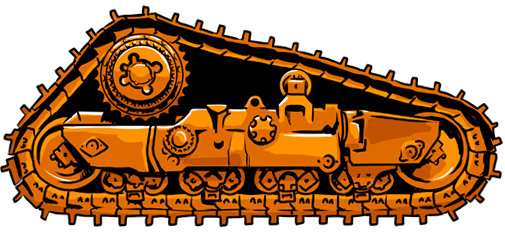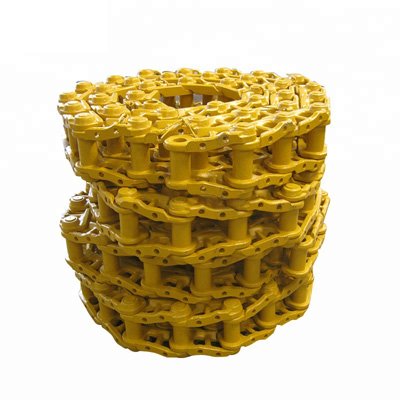Bottom rollers and top rollers (also called carrier rollers) are critical undercarriage components in tracked excavators, providing support and ensuring smooth movement over rough terrain. Here’s a breakdown of their function, structure, and selection factors:
1. Bottom Rollers (Track Rollers)
Function & Importance
Bottom rollers, also known as track rollers, support the entire weight of the excavator and maintain the tension of the track. These rollers are in direct contact with the track chain, enabling smooth movement over various terrains.
Construction & Materials
- Main Body: Made of forged steel or high-carbon steel with heat treatment for durability.
- Shaft (Axle Pin): Generally made from hardened alloy steel (such as 40Cr or 50Mn) to withstand heavy loads.
- Bushing & Bearings: Usually contain bronze or hardened steel bushings to reduce friction.
- Sealing System: Double or triple-labyrinth seals filled with lubricating oil or grease to prevent dirt, water, and debris from entering.
- Surface Hardness: Typically HRC 55-60 to withstand abrasive wear.
Types of Bottom Rollers
- Single-Flange Rollers – Used for smaller excavators or machines operating on stable ground.
- Double-Flange Rollers – Designed for heavy-duty applications, offering better track guidance and load distribution.
Working Mechanism
- When the excavator moves, the bottom rollers transfer the weight of the machine onto the track shoes.
- They roll along the track chain while maintaining alignment and minimizing resistance.
- The lubrication system ensures smooth operation, reducing wear between the shaft and bushing.
Common Failure Modes
- Wear & Deformation: Caused by abrasive materials like sand, rocks, and gravel.
- Oil Leakage: Due to worn seals or internal cracks.
- Flat Spots: Occur when rollers seize up and slide instead of rolling.
- Cracking: Overloading or poor material quality can cause fractures in the roller shell.
2. Top Rollers (Carrier Rollers)
Function & Importance
Top rollers, also called carrier rollers, support the upper portion of the track chain. Their primary function is to prevent track sagging, ensuring proper tension and alignment.
Construction & Materials
- Roller Body: Made from forged and heat-treated steel.
- Axle Shaft: Hardened 40Cr or 50Mn alloy steel.
- Bushings & Bearings: Typically self-lubricating bronze or steel bushings.
- Sealing System: Oil-lubricated labyrinth seals to block dirt and water entry.
- Surface Hardness: HRC 50-58, slightly lower than bottom rollers.
Types of Top Rollers
- Standard Carrier Rollers – Used for light-to-medium duty machines.
- Heavy-Duty Carrier Rollers – Built for high-impact applications, often with thicker walls and reinforced axles.
Working Mechanism
- The top roller guides the upper part of the track, keeping it tight and properly aligned.
- When the excavator moves, the top rollers reduce track whip and misalignment.
- The sealing and lubrication system ensure smooth rolling without excessive friction.
Common Failure Modes
- Bearing Seizure: Due to dirt contamination or lubricant depletion.
- Shaft Bending: Occurs under heavy impact loads.
- Excessive Wear: Due to prolonged use in high-friction environments.
- Oil Leaks: Resulting from worn-out seals or casing cracks.
3. Comparison: Bottom Rollers vs. Top Rollers
| Feature | Bottom Rollers (Track Rollers) | Top Rollers (Carrier Rollers) |
|---|---|---|
| Function | Supports machine weight & track movement | Guides upper track section, prevents sagging |
| Load-Bearing | High (supports full machine weight) | Lower (supports track alignment only) |
| Wear Rate | High (constant contact with ground) | Lower (less direct load) |
| Sealing System | Double/triple labyrinth seals | Single/double labyrinth seals |
| Size | Larger and heavier | Smaller and lighter |
| Failure Risk | More prone to wear, flat spots, and deformation | More prone to bending and oil leakage |
4. Selection Criteria
When choosing bottom rollers and top rollers, consider:
1. Excavator Model & Weight Class
- Each roller is designed for a specific machine weight range.
- For larger excavators (>20 tons), double-flange rollers with reinforced steel shafts are recommended.
2. Terrain & Application
- Soft Ground (Mud, Sand) → Wide rollers with deep-flange designs.
- Rocky Terrain → Hardened steel rollers with wear-resistant coatings.
- Mining & Heavy Construction → Reinforced, heat-treated rollers with high impact resistance.
3. Material & Hardness
- Forged steel rollers last longer than cast steel.
- Hardness should be HRC 55-60 for bottom rollers and HRC 50-58 for top rollers.
4. Sealing & Lubrication
- Choose oil-lubricated, sealed-for-life rollers to minimize maintenance.
- Grease-filled rollers may require periodic servicing.
5. OEM vs. Aftermarket
- OEM (Original Equipment Manufacturer) parts ensure perfect fit but can be expensive.
- High-quality aftermarket rollers offer good performance at a lower cost, but brand reputation matters.
5. Maintenance Tips for Long Service Life
- Regular Inspection
- Check for wear, cracks, and oil leaks.
- Rotate rollers if wear is uneven.
- Keep Tracks Clean
- Mud, rocks, and debris can damage rollers and bushings.
- Pressure wash the undercarriage after each work shift.
- Monitor Track Tension
- Over-tight tracks increase roller wear.
- Loose tracks cause misalignment and impact damage.
- Lubrication Check
- Sealed rollers: No need for additional lubrication.
- Greased rollers: Refill as per manufacturer guidelines.
- Replace Worn-Out Rollers in Sets
- Changing only one roller can cause uneven wear on others.
- Always replace both sides together to maintain balance.
6. Conclusion
- Bottom rollers bear the full weight of the excavator, experience higher wear, and are essential for machine movement.
- Top rollers support the upper track section, preventing sagging and misalignment.
- Selecting the right rollers depends on machine weight, terrain, material hardness, and lubrication system.
- Proper maintenance and inspection significantly extend the service life of rollers.
Would you like recommendations for specific brands, suppliers, or material upgrades?








